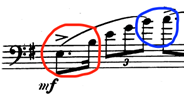Volume 16, October 2022
A Technical Guidance for the Dragonetti Concerto In A Major By Édouard Nanny and Beyond
by Irmak Sabuncu
5. Intonation and Shifting
The G major arpeggio at the opening of Dragonetti Concerto is often a challenge in terms of intonation and shifting (Example 6).
Example 6. Dragonetti, Concerto in A Major, 1, mm. 1-13
The problematic approach is practicing the transition between these notes before being mentally sure about these notes. It often results in frustration. I propose a two-step approach to avoid this issue. The first step is to play these notes one octave lower, which establishes the correct intonation mentally. The second step is shifting, which is the transition between two notes. Let us assume the first note (G) as the departure point and the second note (B) as the arrival point. A common mistake is trying to shift directly without being conscious of the intonation and location of the arrival point. Instead, correctly adopting the departure and arrival points by practicing them individually in terms of location and intonation can achieve a reliable shift more accurately. It is recommended to execute these three notes of G Major arpeggio only by the second finger for a powerful opening.
Some frequent challenges for beginner or intermediate-level players are the uncertainty of the correct intonation and the inability to listen properly. The following section from measures 73-78 in the first movement of the concerto is chosen to work on these issues.
Example 7. Dragonetti, Concerto in A Major, 1, mm. 73–78
A common mistake in executing the first measure is not listening properly to the first two notes, E and B (red), and instead focusing on the high B and C (blue) at the thumb position (Example 8). The important principle for string instruments is that every executed note is a reference to the next. Since the G is harmonic in this passage, it will make the intonation problem even more transparent.
Example 8. Dragonetti, Concerto in A Major, 1, mm. 73
Exercise 19 was tailored based on the challenges previously mentioned. It aims to approach each note individually by neglecting the passage's rhythmic structure. The exercise is structured to play each note accurately and serve as a reference for playing the next note correctly. Notably, executing a staccato in the slur requires applying the right hand after pressing the left-hand note. This practice makes listening to each note easier and obtaining an optimum bow proportion.
Exercise 19. Irmak Sabuncu, Exercise for Intonation and Shifting
Passages like Example 9 become problematic both musically and intonation-wise if they are practiced note by note. However, it is useful to take a look at the structure of the passage before attempting to practice it. The first notes of the triplets and the first note of the next bar (in yellow) are the notes of a B major arpeggio. The next similar sequence is in the key of E minor (marked in purple), then A major (in blue color), followed by D Major (red), and the figure in the green is the G Major 6/4 chord, resolved by a final D major arpeggio.
Example 9. Dragonetti, Concerto in A Major, 1, mm. 76-78
Studying this section as an arpeggio, without the inclusion of its chromatic ornaments (Exercise 20), is beneficial for a more accurate intonation, and it also contributes to a better musical understanding of the passage. The practice method for Examples 7 and 8 is also applicable here.
Exercise 20. Irmak Sabuncu, Exercise for Intonation and Shifting
|






